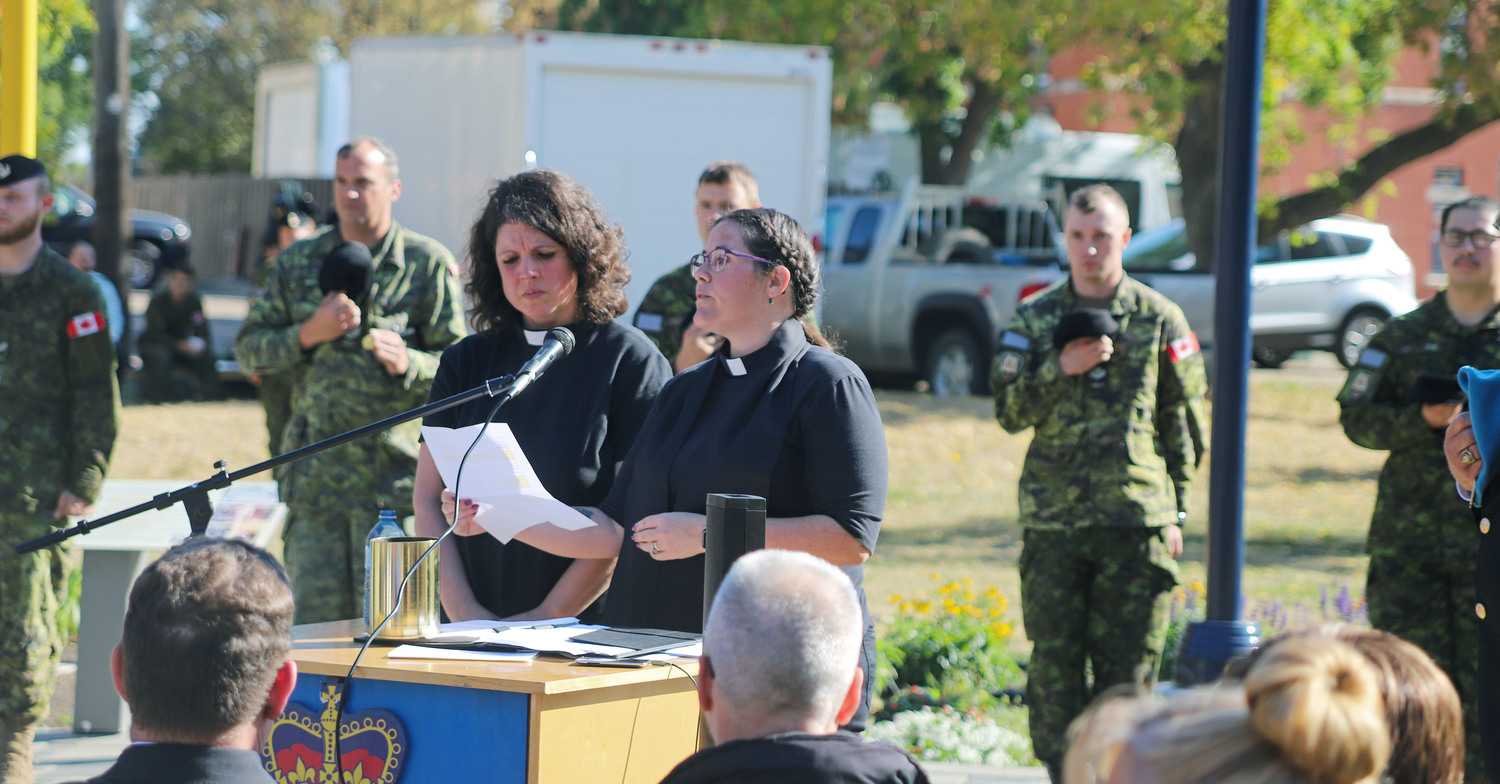In the bright midday sun, against a backdrop of trees beginning to shed their golden leaves, Padre Danielle Key and Pastor Erin Thomas blessed a community park in the heart of Edmonton’s Old Strathcona neighbourhood.
“We both work close to this space and have seen it used by those in our community who need a place of respite, need to find shade under a tree, to find peace among the flowers, and to remember those who have gone before us through the dedication of the plaques that surround us,” said Key, rector of Holy Trinity Anglican Church (HTAC).
“Today we are honoured and privileged to offer a prayer of blessing to this park – dedicating it to the good work that will be done here, to the work that still needs to be done, and to the peace that a space like this provides for all of those in our community, said Thomas, pastor of Trinity Lutheran Church.
The Edmonton Police Service (EPS) Drums and Pipes band led the procession, and the EPS Chorus led a large gathering in singing “O Canada” at the official opening of Light Horse Park, located at 104 Street between 85 and 86 Avenues next to the historic Connaught Armoury and just a short walk from Holy Trinity Anglican (HTAC) and Trinity Lutheran churches.
The Flag Party raised the Canadian and Alberta flags, as well as the camp flag of the South Alberta Light Horse Regiment.
“Light Horse Park was created to build community close to Holy Trinity, the South Alberta Light Horse (SALH) regimental church.” It is dedicated to "All who have lost or been impacted by war and conflict and those left to mourn and remember,” said Stephen “Sticks” Gallard, a retired sergeant major and SALH regiment chief.
The park is now part of the Edmonton Commonwealth Walkway, a 10-km trail system through the North Saskatchewan River Valley. The park’s story, and that of the Regiment, the Anne Frank statue, the community movement to preserve Old Strathcona in the 1970s, and notably the visits of Queen Elizabeth to Edmonton have been added to the Commonwealth Walkway app.
As Gallard told the crowd, Light Horse Park has been many years in the making. Named in 2012 in honour of the SALH Regiment, the park has grown to include a plaza incorporating the Alberta shield, an obelisk (the monument’s top is black to represent the black beret worn by the soldiers of the SALH Regiment); and the Anne Frank statue (dedicated on the 75th anniversary of the liberation of the Netherlands from occupation), is a lasting symbol of the “enduring and unbreakable bond” between the regiment, Canadians and the people of the Netherlands.
Poppies from Flanders Field, grown from seeds gathered during the Regiment’s last overseas battlefield tour, and tulips from Holland, donated by the Edmonton Dutch Canadian Centre, were planted around the Anne Frank statue and at each entrance to the park. The cenotaph rests on a base that was established using soil gathered from every war cemetery in Europe where the remains of Canadian soldiers lie.
The original occupants of the old Armouries in Old Strathcona were the 19th Alberta Dragoons, which were eventually rolled into the SALH, and consider Holy Trinity to be their Regimental Church.
“During World War One, soldiers mustered and exercised their horses on the grounds of what is now Light Horse Park,” says Gallard. “They would have processed through the armouries across the street to what is now End of Steele Park to board trains. Parish members and clergy would give the troops a sendoff east to the ships that would take them to the battlefields of Europe…”
In recent years, SALH realised the area is becoming home to a greater number of refugees from Syria, Afghanistan, Ukraine, and other places in the world from which they were forced to flee.
“They bear the mental and physical wounds of war,” Gallard says. “We wanted to create a place of reverence and remembrance for all community members. A place where people can go and be welcomed no matter their background. A place where they can go and not feel alone; to remember their losses in peace and acceptance.”
The next phase of the park’s construction will include the installation of entrance columns displaying the Regiment’s history, as well as memorial plaques rescued from neighbourhood buildings prior to their demolition.
Following the program, people were invited to stay for a barbecue in support of refugees and to take in a display of vintage police and military vehicles parked along 104 Street in the shade of the trees.









































